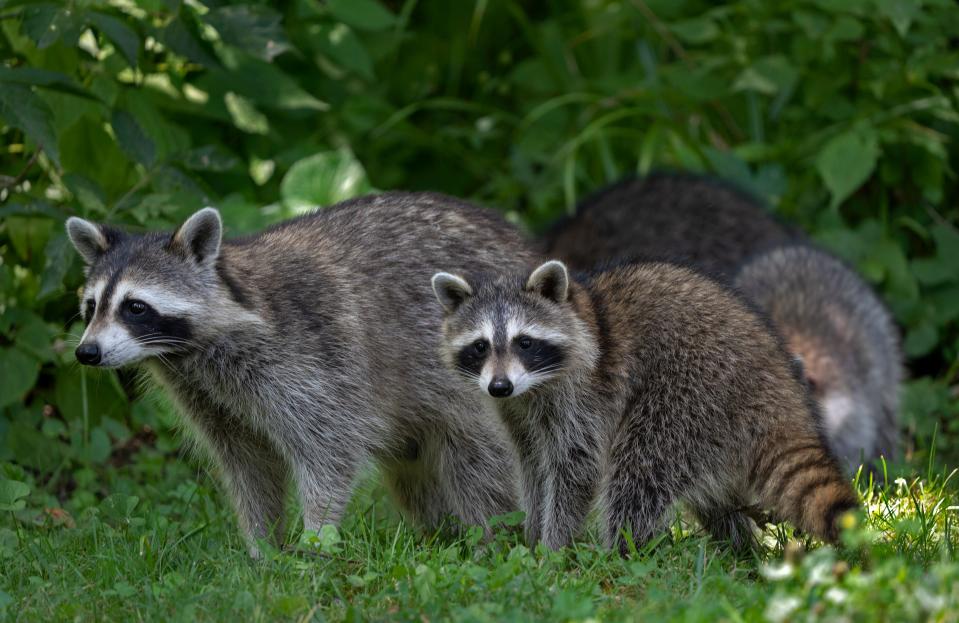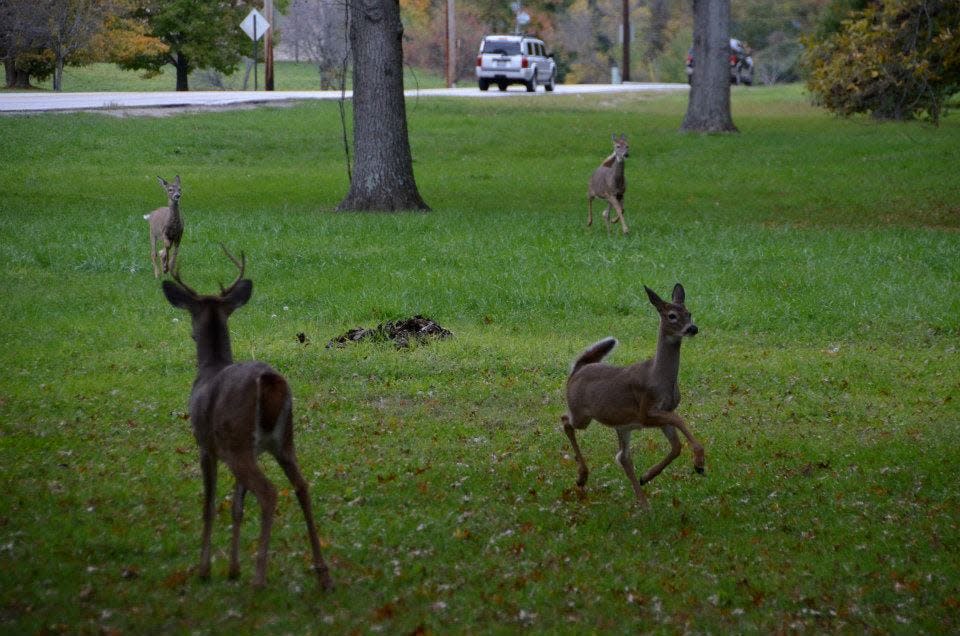Climate change is causing problems for your squirrel neighbors, too
Indiana's native wildlife have it hard enough as it is: Urban development is encroaching on their habitat and taking away their space. Now, according to a new study, climate change is making it even worse.
Researchers at Butler University, in partnership with the Urban Wildlife Information Network, co-authored the study that found Indiana's warming temperatures are increasing the potential problems mammals face in urban settings with too little green space.
“I think what the really powerful finding from this study was that we confirmed what people have seen for many years now,” said Carmen Salsbury of Butler University. “There is a negative impact of urbanization on species diversity and species richness on the landscape.”
Hotter and drier cities with little greenspace are most at risk to create problems for native mammals due to development and warming, researchers found.
Scientists in agencies across the world have found that the Earth’s average temperature has risen 1.8 degrees Fahrenheit since 1880 and the increase is directly related to the release of greenhouse gases.
“Clearly trying to control climate change is a good thing,” Salsbury said.
Raccoons, squirrel and rabbits were some of the most commonly observed mammals in the study. While those smaller animals were abundant, others including deer, coyotes and bobcats were also seen. Animals with flexible diets, like raccoons, are able to find more food in urban environments. Wildlife with more specialized diets, especially herbivores, are more sensitive to the loss of greenspace.
A diverse population of wildlife — both large and small, with differing diets — are important to a healthy ecosystem.
"If we don't maintain that biodiversity, we end with with a situation where things get out of balance," Salsbury said.
An off-balance ecosystem will negate the benefits of a healthy system, such as filtering water and sequestering carbon. A loss of one species also may provide another with an opportunity to thrive. Imagine if rats lose their predator, that can lead to a city-wide infestation and cause trouble to the urban area.

How researchers track climate change and urbanization
A large team of researchers conducted the study in 20 cities across North America, including Indianapolis, by using wildlife cameras in hundreds of sites throughout the summer months. The team wanted a wide range of cities with different population density, as well as various amounts of impervious surfaces, moisture and temperature to provide a comprehensive look at the issue.
Fewer species were found in cities with less green space, and the researchers wanted to understand the potential effects that climate change’s warming trend would have on the loss of biodiversity, Salsbury said.
Dense urban infrastructure, such as buildings and pavement, absorb and retain heat. Green space, such as trees and vegetation, are important to these areas because they reduce the heat island effect by providing more shade and deflecting the sun, according to the U.S. EPA.
“Why should we care whether we have all these animals present or not? I think that what I can say in a simple response is that biodiversity is critically important to functioning ecosystems,” Salsbury said.
Solutions for protecting Indianapolis biodiversity
More wildlife is found in cities that have maintained more undisturbed habitat, Salsbury said, and preserving those areas is important to mitigate the negative effects seen in the study.
“I think, for Indiana, that most of the information from this study sort of points to our need to really focus on greenspace and connectivity within our cities to sort of help mitigate what we know is probably coming with regard to climate temperature increases,” Salsbury said
Not all greenspace is equal, and a May report from SAVI, out of Indiana University, concludes that “further greenspace development should be prioritized” in Marion County. The report says particular attention is needed in lower income minority areas still affected by historic inequities.
Shannon Killion, stormwater administrator for the City of Indianapolis, said the city’s Department of Public Works is changing its focus to pay more attention to resiliency and sustainability.
“We all know that part of our greenspaces really factors into that (focus),” Killion said.
The department has already started implementing this new focus by hiring an additional urban forestry inspector and another senior project manager in stormwater. The urban forestry team is tasked with maintaining and expanding the public forest in the city, which includes trees along the streets and in certain areas of parks, Killion said.
“Trees have tremendous environmental benefits not only from providing habitat and cooling impacts, but they also have positive stormwater benefits as well to intercept stormwater and in numerous other things to really offset some of the detriments that come with urban development historically,” Killion said.

It’s important the city plans diverse greenspaces, utilizing a variety of native vegetation, because pests such as the emerald ash borer can wipe out monocultures and intentional planning will lessen that impact, Killion said.
DPW also employs a land stewardship team that maintains native spaces primarily in park locations.
“If you think of Eagle Creek Park, there's spaces that the land stewardship team maintains and they're focused on the removal of invasive species and making sure that we have a well-balanced environment,” Killion said.
Alex Cortwright, with Indy Parks and Recreation, said these larger city parks are an opportunity to preserve some of the trees that are already there and opens the chance to plant more.
“A lot of that vegetation is very specific to make sure that we're using what makes sense for the ecosystem by using what is going to have the best conservation and climate impact,” Cortwright said.
Facing hurdles when expanding greenspace
Providing ample and efficient greenspace in urban areas is not equal across cities. Different challenges face cities that build more densely than cities that sprawl out.
“A really condensed urban area has the advantage of not taking up as much space, which is positive,” Salsbury said. “Sprawl takes up space, but you can potentially integrate more greenspace, which may be important.”
For a sprawling urban area like Indy, Salsbury said planners need to be very deliberate about where to maintain parks and greenways.
While the study does not directly discuss connectivity between natural areas, Salsbury said it is an important characteristic in cities to maintain diverse populations of wildlife.
“One of the things that we know is the case is that when you have fragmented habitats you’re limiting habitat space or size, potentially,” Salsbury said. “When you can connect habitats together, that in a sense is more helpful for those larger animals that require greater greenspace.”
When it comes to Indy planning out parks and greenspace, Cortwright said funding is a big part of the challenge. The parks department does not have a dedicated land acquisition fund and buying land can be competitive.
The city in 2021 told IndyStar that the park system relies on donations or developers offering greenspace to acquire new land. The city-county council and mayor have been supportive of land acquisition efforts like the Grassy Creek Regional Park addition in 2021, Cortwright said recently.
A recent grant from the Land and Water Conservation Fund through DNR allowed Indy Parks to provide more amenities such as a hiking trail at Rev. Charles R. Williams Park just north of East 30th by Fall Creek.
Indiana wildlife: Here's what you need to know about new wildlife research unit coming to Indiana
Most of the park department’s master planning, where these decisions are made, includes a period of community input, Cortwright said.
“A lot of times we'll hear from community members and counselors who are like, ‘Hey, there's this spot in my district or community that would be great to get a park in,’” Cortwright said.
From there, it’s about the feasibility of building a park and getting that funding.
Salsbury and the Butler University researchers are now trying to look at their data from the study to get a good picture of what is happening the distribution and abundance of native mammals specifically in Indianapolis. Within the next year, they hope is to bring those findings to Indy Parks to help guide future planning.
“Ultimately, the overarching answer is do things to control our carbon emissions and get climate change under control,” Salsbury said. “At same time, looking at our neighborhoods, our cities, and paying attention to those greenspaces can help to enhance those greenspace is important.”
Karl Schneider is an IndyStar environment reporter. You can reach him at karl.schneider@indystar.com. Follow him on Twitter @karlstartswithk
IndyStar's environmental reporting project is made possible through the generous support of the nonprofit Nina Mason Pulliam Charitable Trust.
This article originally appeared on Indianapolis Star: Climate change, development threatens Indy wildlife, study says

